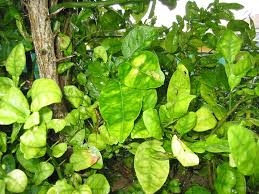In a Fort Pierce, FL, field planting, plant growth, and Huanglongbing (HLB)
severity were assessed as indicators of HLB tolerance on progenies of 83 seed-source
accessions of Citrus and Citrus relatives mainly from the Riverside, CA, genebank. The
HLB-associated pathogen [Candidatus Liberibacter asiaticus (CLas)] and vector [asian
citrus psyllid (ACP), Diaphorina citri] were abundant, and trees were naturally
challenged for 6 years before metrics (leaf mottle, percent canopy mottle, overall health,
canopy density, canopy width, canopy height, and trunk diameter) were collected in Oct.
and Nov. 2015. The healthiest trees with low or no HLB symptoms were distant citrus
relatives: Balsamocitrus dawei, Bergera koenigii, Casimiroa edulis, Clausena excavata,
Murraya paniculata, and one accession of Severinia buxifolia. Within Citrus, most of the
healthiest trees with densest canopies, little leaf loss, and greater growth were those with
pedigrees that included Citrus medica (citron). These included progenies of Citrus hybrid
(‘Limon Real'), Citrus limetta, Citrus limettioides, Citrus limonia, C. medica, Citrus
volkameriana, and some Citrus limon accessions. Trees in this category exhibited distinct
leaf-mottle characteristic of HLB and substantial pathogen titers, but maintained dense
canopies and exhibited good growth. Trees from seed-source accessions in the genus
Citrus without citron in their background were generally among the least healthy overall
with less dense canopies. The exceptions were progenies of two Citrus aurantium
accessions, which were markedly healthier than progenies of other Citrus seed-source
accessions not derived from citron. Linear regression analysis, between metrics collected
and pedigree of seed parent, indicated that percentage of citron in the pedigree
significantly correlated with measures of tolerance. Although no commercial Citrus
genotypes yielded progenies with strong HLB resistance, in this field experiment several
progenies maintained dense canopies and good growth, and may be useful for breeding
HLB tolerant cultivars.
HORTSCIENCE 52(1):31–39. 2017. doi: 10.21273/HORTSCI11374-16
Photo: HLB Leaf Symptoms
Attached Images:
